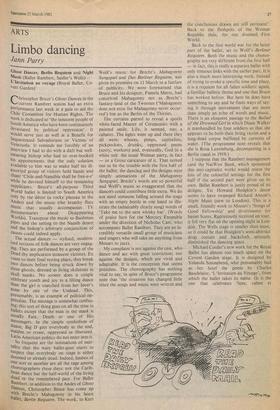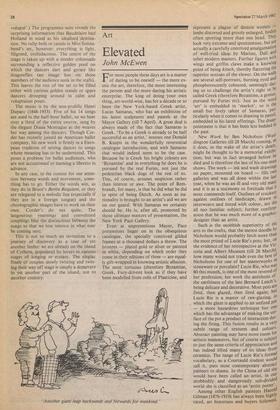ARTS
Limbo dancing
Bann Parry
Christopher Bruce's Ghost Dances in the current Rambert season had an extra Performance last week at a gala to aid the Chile Committee for Human Rights. The work is dedicated to 'the innocent people of South America who have been continuously devastated by political oppression'. It would serve just as well at a Benefit for Sequestrated Salvadorians or Victims of Venezuela. It reminds me forcibly of an interview I had to do with a daft but well- meaning bishop who had so over-booked his appointments that the only solution available to him was to make half his ill- assorted group of visitors hold hands and chant 'Chile-and-Namibia shall be free-e-e' while he devoted himself to the remaining supplicants. Bruce's all-purpose Third World ballet is limited to South America Only by the decor (a rocky plateau in the Andes) and the music (the breathy flute Music that usually accompanies TV
documentaries about Disappearing Worlds). Transpose the music to Bushman Pipes and the setting to the Namib desert and the bishop's arbitrary conjunction of causes could indeed apply.
The actual dances — stylised, modern- ised versions of folk-dances are very engag- ing. They are performed by a group of the Dead (by implication innocent victims). En route to their final resting place, they break Into dances before being struck down by three ghouls, dressed as living skeletons in skull masks. No sooner does a couple celebrate youth and joy in a lilting dance than the girl is snatched from her lover's arms by one of the Undead. This, presumably, is an example of political op- pression. The message is somewhat confus- ing: this sort of thing goes on all the time in ballets except that the man in the mask is usually Fate, Death or one of His messengers. In the simple symbolism of dance, Big D gets everybody in the end, maiden or crone, oppressed or liberated. Latin American politics do not enter into it.
So frequent are the intimations of mor- tality that the wary ballet-goer starts to suspect that everybody on stage is either doomed or already dead. Indeed, limbos of one sort or another are all the rage among choreographers these days: not the Carib- bean dance but the half-world of the living dead or the remembered past. For Ballet Rambert, in addition to the Andes of Ghost Dances, Christopher Bruce has come up with Brecht's Mahagonny in his latest ballet, Berlin Requiem. The work, to Kurt
Weill's music for Brecht's Mahagonny Songspiel and Das Berliner Requiem, was given its premiere on I I March to a fanfare of publicity. We were forewarned that Bruce and his designer, Pamela Marre, had conceived Mahagonny not as Brecht's fantasy-land of the Twenties (`Mahagonny does not exist for Mahagonny never occur- red') but as the Berlin of the Thirties.
The curtains parted to reveal a spotlit white-faced Master of Ceremonies with a painted smile. Life, it seemed, was a cabaret. The lights went up and there they all were; whores, pimps, capitalists, pickpockets, drunks, oppressed peons (sorry; workers) and, eventually, God in a white suit: the usual Weimar party, in fact — or a Grosz caricature of it. That turned out to be the trouble with the first half of the ballet; the dancing and the designs were simply animations of the Mahagonny Songspiel. Brecht's words are so powerful and Weill's music so exaggerated that the dancers could contribute little extra. We do not need someone falling around the stage with an empty bottle in one hand to illu- strate the (admirably clearly sung) words of `Take me to the next whisky bar'. (Words of praise here for the Mercury Ensemble under the direction of Nicholas Carr, who accompany Ballet Rambert. They are an in- credibly versatile small group of musicians and singers who will take on anything from Mozart to jazz).
My complaint is not against the cast, who dance and act with great conviction; nor against the designs, which are vivid and adaptable. It is the conception that seems pointless. The choreography has nothing vital to say, in spite of Bruce's programme note that 'the situation has changed little since the songs and music were written and the conclusions drawn are still pertinent'. Back to the fleshpots of the Weimar Republic then, for our doomed First World.
Back to the first world war for the latter part of the ballet, set to Weill's Berliner Requiem. Both 'the music and the choreo- graphy are very different from the first half — in fact, this is really a separate ballet with only tenuous links with the earlier part. It is also a much more interesting work. Instead of trying to evoke a specific time and place, it is a requiem for all fallen soldiers: again, a familiar balletic theme and one that Bruce has worked before. But here he does have something to say and he finds ways of say- ing it through movements that are more than simply an echo of words and music. There is an eloquent passage to the Ballad of the Drowned Girl in which Diane Walker is manhandled by four soldiers so that she appears to be both their living victim and a long-dead corpse buffeted by currents of water. (The programme note reveals that she is Rosa Luxemburg, decomposing in a Berlin canal in 1919.) I suppose that the Rambert management (and the NatWest Bank, which sponsored this anti-capitalist work) would resent the loss of the colourful settings for the first half if the second part were given on its own. Ballet Rambert is justly proud of its designs. Yet Howard Hodgkin's decor seems to have swamped Richard Alston's Night Music (new to London). This is a small, friendly work to Mozart's 'Songs of Good Fellowship' and divertimenti for basset horns. Rapturously received on tour, it fell very flat on the opening night in Lon- don. The Wells stage is smaller than most, so it could be that Hodgkin's semi-abstract drop curtain and backcloth , seriously diminished the dancing space.
Michael Corder's new work for the Royal Ballet has almost too much space on the Covent Garden stage. It is designed by Yolanda Sonnabend, who presumably had as her brief the poem by Charles Baudelaire, `L'Invitation au Voyage', from which the ballet takes its name. (It is the one that celebrates 'luxe, calme et
volupte'.) The programme note reveals the surprising information that Baudelaire had Holland in mind as his idealised destina- tion. No tulip beds or canals in Miss Sonna- bend's set, however: everything is light, filigreed, orchidaceous. The centre of the stage is taken up with a slender colonnade surrounding a reflective golden pool on which the dancers dart and gyrate like dragonflies (an image lost on those members of the audience sunk in the stalls). This leaves the rest of the set to be filled either with curious golden stands or spare dancers drooping around in calm and voluptuous poses.
The music is by the non-prolific Henri Duparc (1848-1933). Five of his 14 songs are used in the half-hour ballet, so we hear over a third of the entire oeuvre, sung by the elegant Diana Montague as she weaves her way among the dancers. Though Cor- der has recently joined an American ballet company, his new work is firmly in a Euro- pean tradition of setting dances to songs whose meaning has to be understood. This poses a problem for ballet audiences, who are not accustomed to learning a libretto in advance.
In any case, in the contest for our atten- tion between words and movement, some- thing has to go. Either the words win, as they do in Bruce's Berlin Requiem, or they are relegated to a melodic line (especially if they are in a foreign tongue) and the choreographic images have to work on their own. Corder's do not quite. The langourous yearnings and convoluted couplings blur the distinctions between the songs so that we lose interest in what may be coming next.
This is not so much an invitation to a journey of discovery as a tour of yet another limbo: we are already on the island of Cythera, populated by lovers in various stages of longing or ecstasy. The elegiac finale of couples slowly twisting and twin- ing their way off stage is simply a departure to yet another part of the island, not to another country.
`Another giant leap backwards and forwards for mankind.'





































 Previous page
Previous page